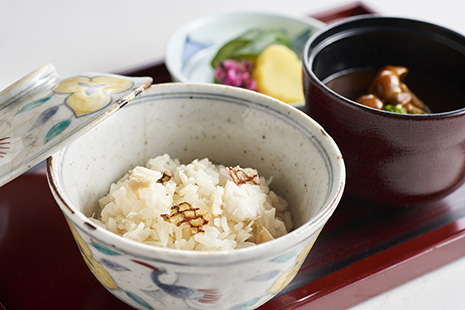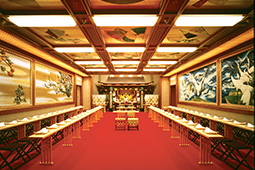May 2023
- English
- 日本語
A Delicate Sea Bream Dish Enhances a Japanese Wedding Reception
-

Tai-meshi is a particularly popular dish on the wedding banquet menu: a sumptuous offering of rice cooked with natural sea bream. -

A traditional wedding ceremony at Hotel Gajoen Tokyo, an integrated wedding hall venue pioneer.
-

The hotel is situated in the heart of Tokyo, but its lush greenery delights guests. -

A gorgeous shrine where the bride and groom, along with relatives, hold a Shinto ceremony. -

A sumptuous Japanese course featuring such delicacies as tai-meshi (rice with sea bream). The second dish from the left in the lower left corner is tai-meshi.

We asked the long-established hotel, which is famous as Japan's first integrated wedding hall venue, about sea bream dishes that are served at wedding receptions.
Until the 19th century, Japanese weddings were typically held at home. The form of wedding ceremony where the couple's wedding is wedded with Shinto rites, then followed by a wedding banquet (called hiroen), began in 1900 with the marriage ceremony of Emperor Taisho, who was then Crown Prince of Japan, and Empress Teimei.*

The hiroen is a festive banquet held after a wedding, and relatives, friends and other acquaintances are invited. The kaiseki cuisine served at such banquets is a simplified version of honzen-ryori,** the most prestigious of Japan's traditional culinary styles, which has been developed and refined since the 14th century. Like some other types of Japanese cuisine, honzen-ryori evolved from ancient court cuisine. Including sea bream on the menu as an auspicious fish is considered a long-standing tradition. In the formal arrangement of honzen-ryori, the main zen (a small dining table) is called the honzen, and rice, miso soup, and other dishes are placed on it. Festive banquets at Hotel Gajoen Tokyo feature tai-meshi, a rice dish with sea bream, which is equivalent to a honzen-ryori main dish.

Hotel Gajoen Tokyo was established as a ryotei (Japanese-style restaurant) more than 90 years ago, and it is said that its predecessor and roots lie in Meguro Gajoen, which is said to be the pioneer of comprehensive wedding halls in Japan. The ryotei tradition is still carried on in the hotel's wedding hiroen banquet menu, which now offers course meals with 8 to 10 dishes.
We asked Hotel Gajoen Tokyo's Public Relations Department about the hotel's cuisine.
"We painstakingly select the choicest ingredients from all over Japan with our guests in mind. We prepare everything by hand, from the dashi (soup stock) to the tare (sauce). In particular, our supervising head chef always checks the amount of salt, which is crucial to the taste of Japanese food, even on days when we hold many weddings, to ensure that high quality is maintained."

In addition to the food, careful attention is also given to the tableware and how the food is presented.
"For tableware and presentation, we keep in mind the color schemes and gorgeous touches that are unique to wedding ceremonies. We are especially intent on creating a memorable experience for the bride, the groom, and their guests."
The most popular and delicately flavored dish on the hiroen menu is the tai-meshi.
"The sea bream used for tai-meshi is completely natural. The day before the fish is used, we prepare it with strong salt to remove odor and moisture. On the same day, we bake the slightly salted sea bream in the oven at 155 °C for about 15 minutes to lock in the flavor, and then cook it with the rice."

This venerable hotel's culinary spirit inherited from the ryotei (traditional Japanese restaurants) shows that the legacy of Japan's age-old food culture is being carried on to this day. This spirit is evident in tai-meshi.
* In 1900, for the first time in the Imperial Household, a marriage ceremony was held in front of the kashikodokoro, which enshrines the Imperial Ancestor worshipped as a deity, for the wedding of Taisho, the 123rd Emperor (who was then Crown Prince) and Empress Teimei (posthumous title), and a banquet was then held separately.
** The most formal style of Japanese cuisine, established in the Muromachi period (mid-first half of the 14th century to mid-late 16th century). The food is served on a zen, a small dining table on which several dishes, usually lacquered, are placed. The dishes are presented separately—from the honzen (the main zen), to ninozen (the second zen), sannozen (the third zen) etc., and are served to each person one by one.

